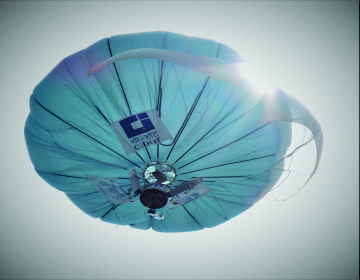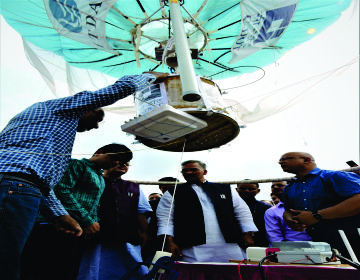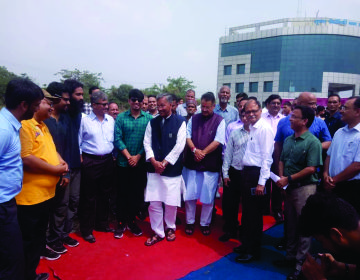


Aerostat for Post Disaster and Last Mile Connectivity
July 16, 2013 Kedarnath, Uttarakhand, India, a pilgrimage town nestled in the Himalayas, bustling with activity, just about to end its tourist season when one of the deadliest tragedy struck. Flash floods completely flattened the town within minutes with thousands stuck in the debris and mud, battling for life. Many victims could not be saved as the first responder rescue teams could not establish timely contact with the base teams for reinforcements because of the complete breakdown of communication infrastructure.
One of the first responders from the Government of the state of Uttarakhand contacted our laboratory requesting for an intervention in the form of a portable, quick deployable and height-adjustable aerial platform to raise communication equipment to establish contact in disaster situations and dark communication zones. The conventional approach to provide communication is to mount antennas (typically directional) on a high tower, which are then connected to the wireless bridges. These antennas look at client side antennas through line of sight (LOS) connectivity. In any disaster situation, whether natural or man-made, the first casualty is usually this telecom infrastructure. Moreover, these towers are generally non-relocatable and non-height adjustable.
On the other hand, Aerostats (Balloon based systems) an outcome of Lighter-Than-Air (LTA) Technology, work on static lift production concept based on Archimedes Principle wherein, density difference between an LTA gas (usually Helium or Hydrogen) and the ambient air results in buoyant lift that overcomes gravity. Aerostats are aerial platforms with LTA gas filled inside a suitably sized and shaped envelope to lift themselves as well as any onboard mounted payload. They are tethered to the ground using a winching system, which can reel in or out the tether, depending on the desired deployment height. A ground stand is required for secure mooring and ground handling of the system. Aerostat systems find a wide range of applications as relocatable and height adjustable aerial platforms with exceptionally high endurance and low operating costs, since they do not consume any fuel to remain afloat in the air. The fuel or energy consumption for any other system would be very high, if it is to accomplish the same task.
These advantages compelled us to develop an Aerostat (Balloon based) system with self-stabilizing capability on proof-of concept basis, which can be deployed with communication payload. The primary challenge for any kind of aerostat design is its stability in high winds. This led us to design a sail based system, which has a semi skirt around its maximum diameter, which stabilizes it by creating a high pressure zone just below the envelope. The trials of the system were accomplished successfully at two sites namely, Ahmednagar, Maharashtra and I.T. Park, Dehradun, Uttarakhand in February and June 2018, respectively. In the first trial in Ahmednagar only an RF antenna was deployed onboard but in the second trial in Dehradun three types of communication antennas were deployed for 2G, 3G, 4G, calling and internet signal establishment namely, RF antenna, Sector antenna and VHF Police Wireless Antenna. Honorable CM of Uttarakhand Mr. Trivendra Singh Rawat, inaugurated the event and deployed the system.
The results observed were very encouraging, which established the efficacy of tethered aerostats for communication establishment. The system was seen to have a stable behavior for up to 40 km/hr. wind speeds. A communication radius of 2 km could be established using the RF antenna, 1km using a Sector antenna and about 40 km using VHF wireless antenna. The systemwas deployed for 5 days at altitudes ranging from 50m to 120m while being brought downonly for changing the payload. The system was kept in deployed state even in drizzling rain without any damage.
Current work is focused on further developing the system into a user-friendly product. The operational complexities noted during trials are being worked upon to make this system even more portable and less time consuming to deploy. Also, possibility of making the system stable at even higher wind speeds is being currently worked out.
IIT Bombay
Technology Development: Indian Institute of Technology Bombay (IIT Bombay), Mumbai, Maharashtra
Team IIT Bombay:
- Dr. Rajkumar S. Pant, Professor- Aerospace Engineering. Department (AED),
- [email protected], LTA Systems Laboratory (IIT Bombay) - 022-25764115
- Mr. Vishaal Sharma, ex-Assistant Project Manager, AED,
- Mr. Chetan Dusane, Assistant Project Manager, AED,
- Mr. Raman Verma, Project Research Assistant, AED
Recent Articles
Combating Forest Fires: Strategies, Challenges, an...
Contributed by:
Mr Bharat Parekh
Vice President
Fire Safety Devices Pvt Ltd
Forest fires, also known as wildfires, are among the most destructive natu...
The Significance of Safety in the Workplace
The Significance of Safety in the Workplace
Contributed by
Mr Rahul Sakhuja
Director
Safety Experts
In today&rsq...
Guardians of Safety: The Vital Role of Flame Detec...
"Guardians of Safety: The Vital Role of Flame Detectors in Industrial Environments"
Contributed By:
Mr. Ashish Shah
CEO, Ambetronics Engineers Pvt. Ltd.
...Protective Footwear: A Crucial Element of Occupati...
Protective Footwear: A Crucial Element of Occupational Safety and Health
Contributed by:
Mr. H. S. Bahety
CEO, Unistar Footwear Pvt. Ltd.
In any w...
Ensuring Fire Safety: The Importance of Testing &a...
Ensuring Fire Safety: The Importance of Testing & Certificationas per Indian Standards
Author: Sandy Dweik, CEO of Thomas Bell-Wright
Fire safet...

